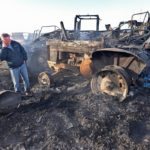A fire in a machine shop at a dairy farm north of Osler, Sask., earlier this week is estimated to have caused $1.8 million in damage. Firefighters from nearby towns responded to the blaze in Mark Wiebe’s shop about 9 p.m. Monday March 19th. Fire departments from Warman, Osler, Martensville and Dalmeny fought the blaze […] Read more
News

As trade tensions mount, China soybean buyers devise contingency plans
BEIJING (Reuters) – Chinese buyers of soybeans, the United States’ biggest agricultural export to the country, are quietly drawing up contingency plans to ensure supplies of critical raw materials in the event of a trade war, sources said. The moves are the strongest sign yet that businesses in the world’s most populous country are growing […] Read more

Alta. budget gives ag slight boost
Alberta farmers can anticipate more funding for energy and insurance programs, and even a few more occupational health and safety officers on the ground, according to the 2018 provincial budget. The budget, tabled yesterday, shows Alberta will spend roughly $1.1 billion at the Ministry of Agriculture and Forestry, which is $42 million more than was […] Read more
Ag Canada releases slight supply/demand table adjustments
Winnipeg (CNS Canada) – Agriculture and Agri-Food Canada included only minor adjustments in their latest supply/demand tables, released on March 22. The market analysis branch of Agriculture Canada left its production estimates unchanged for the upcoming 2018/19 growing season. Ending stocks of the major grains and oilseeds for 2018/19 were lowered to 13.875 million tonnes, […] Read more

40,000-acre farm goes organic
WALDRON, Sask. — There are 25 grain bins in Travis Heide’s farmyard, including six massive ones with a capacity of 70,000 bushels each. In total, the bins can store around 550,000 bu. of grain. That’s enough for 10,000 acres of spring wheat, assuming an average yield of 55 bu. per acre. For most prairie farmers, […] Read more

Orphan wells: Alberta’s $47 billion problem
As energy sector companies fail, landowners wonder who’s on the hook for reclamation costs of wells and pipelines
TABER, Alta. — As farmers drove to the March 8 Action Surface Rights meeting, the news had just broken that Calgary-based Sequoia Resources Corp. had ceased operations. Its demise, if it occurs, would add at least another 2,300 oil and gas wells and possibly as many as 4,000 to the list of energy infrastructure sites […] Read more
Railways miss their own delivery targets
There are many factors that can affect how quickly harvested grain moves from a remote farm location in Western Canada to an outbound ocean vessel on Canada’s West Coast. According to sources in the grain industry, the main factors behind this year’s shipment delays aren’t much different than usual — bad weather and bad industry […] Read more

‘Paid hunting’ fee proposed to access land
Alta. ranchers look for solutions as tension builds between those who lease public land and those who want to use it
BROOKS, Alta. — An email sent to Fort Macleod, Alta., area rancher Bill Newton last fall was initially polite. A prospective hunter requested access to grazing land that Newton leases, specifying when and where he wanted to hunt. Newton sent a polite reply, refusing access due to excessively dry conditions and the heightened risk of […] Read more
Barley may thrive under climate change
Climate change could result in warmer and wetter conditions in northern Alberta and warmer and drier in the south
A warming climate could be good news for Alberta’s barley industry. University of Alberta researchers have embarked on a ongoing project to study adaptive measures and opportunities for water use for agriculture, petroleum and other sectors in the province. Watershed scientist Monireh Faramarzi and others have combined hydrology and climate models to assess water supplies […] Read moreSystem maps out best bio-energy sites in Alta.
Called BRIMS, the application tells investors how much agriculture supply there is to help decision making
Companies looking to invest in biofuels or other bio-resources can now more easily look for places to set up in Alberta, thanks to a new online resource. The application, called the Bio-Resource Information Management System, or BRIMS for short, was developed by Alberta Innovates, an arms-length government agency, and Silvacom, a consulting and software company […] Read more



